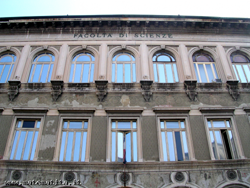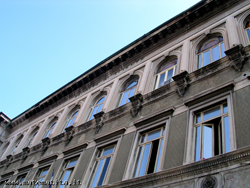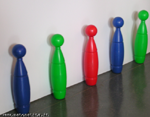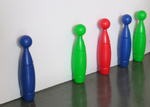Projective geometry
This is the text of the poster you can see here.
From Shadow to Shadow
What is left invariant in pictures (taken from different angles) of the facciata of the same house, in pictures of the same discor of something else? What changes in them?
What is left invariant in the three different shadows that the same cardboard contour projects on a plane when it is enlightened from different angles? What changes in them?
If we disregard chromatic issues and we just observe the outline of the images, in both cases differences are more numerous than common characteristics.
In a close-up shot, the shape of the doors will be similar to a rectangle. In a foreshortened picture, the shape of the doors will be that of an irregular quadrangle. If one of the picture is taken from above and the other from below, the proportion among the different parts will be totally distorted and so on.
The shadow of a disc can be a circle as well as a more or less stretched ellipsis or something else; it depends on the position of the plane with respect to the light.
Yet, there is something in common between the two pictures or the two shadows: for example, the straight lines in a picture stay straight in the other picture too. The shadows of the disc have a “soft” outline without tips nor bumps.
If you ask if there exists a transformation of the plane that sends a picture of the façade to the other or if there exists one that sends a shadow of the contour to the other, the answer is positive in both cases. The transformation in both cases is a projectivity of the plane.
The two pictures of the façade – or the two shadows of the contour – are equal from the viewpoint of projective geometry, which investigates them as though they were the same thing.
Projectivities alter the length and the ratio of length of segments. Two identical windows in real life are rather different in a foreshortened picture. None the less, everyday experience says that there is something that allows one to recognize regularity in foreshortened images. Look at the images below…
Evidently, the pins that appear in picture 1 are not positioned in a regular way. On the other hand, the distance between those in picture 2 is the same although the actual distance between each image $is different and decreases.
What makes us recognize regularity in the first picture? Or, more specifically, what makes us exclude regularity in the second one?
It is the cross-ratio, a numerical invariant of projective geometry. Although lengths and ratios of lengths of segments are not preserved under projectivities, the ratio of the ratio of aligned segments is. Given four points A,B, C and D on a line, the ratio between the two ratios AC/BC and AD/BD – or their cross-ratio (ABCD) – coincides with the cross-ratio (A’B’C’D’) of their images under any projectivity.
If you take four points on a line and at the same distance, their cross-ratio is 4/3. Thus, all their projective images have the same cross-ratio 4/3. In picture 1, the cross-ratio of the “bases” of the pins is not 4/3, whereas the cross-ratio of those in picture 2 is 4/3. Although we are not aware of it, our mind is trained to detect it: it can “measure” some cross-ratios before we realize it!



